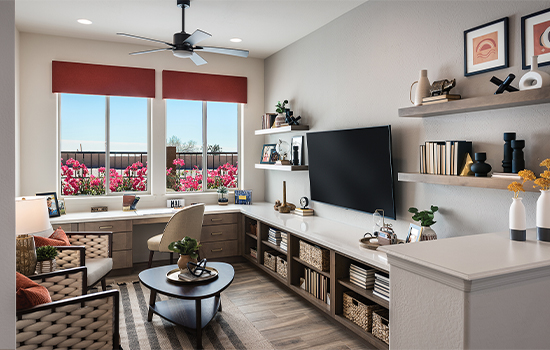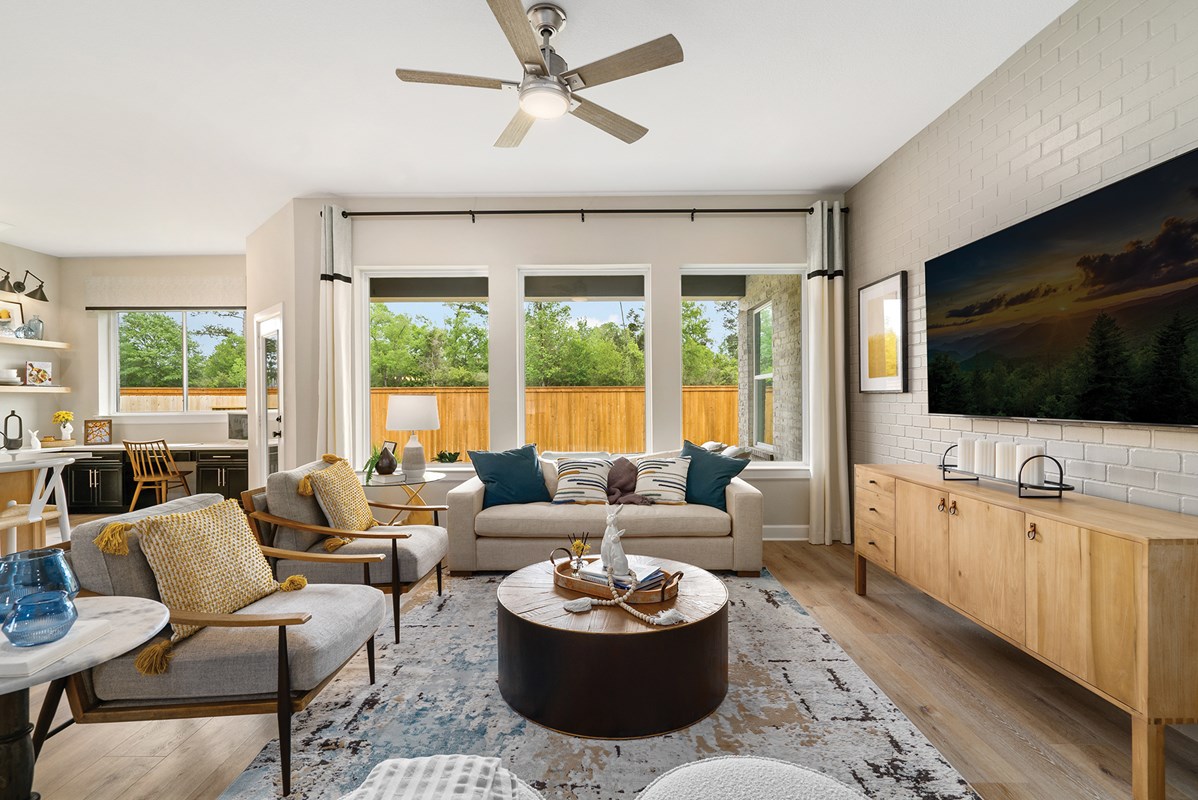Published December 13, 2023
In-Depth Look at Transitional Design Style
Learn about transitional style and how to use it to create a timeless and impressive look in your home.
What is Transitional Style?
Transitional interior design blends elements of traditional and contemporary styles to create something new, unique, and yet still familiar. That may sound similar to other design aesthetics, but it is specifically the combination of contemporary and traditional elements coexisting that sets transitional style apart.
Transitional style is all about creating a sense of depth to keep the eye moving across the space, from focal point to focal point. The end result should be a balanced and unified impression of easy, comfortable elegance.
You can achieve this style in your own home with a careful eye for colors and textures, clean lines and refined curves, balanced accessories and sophisticated comfort.

Color, Texture and Focus in Transitional Design Style
Transitional style is calm, curated and charming. Experts start with a baseline of soft, neutral tan, cream, taupe, gray, white and beige foundations. From there, you build up with focal points of complimentary color, such as rich greens, shy blues, sophisticated browns and unobtrusive reds.
However, not all focal points need to pop with color. Soft wool, classic suede, antique wood, clean linen, well-maintained leather, dark rattan and framed glass are all classic textures the experts use in their transitional designs. Textural interest, even in the soft baseline colors, can add depth and class to a space without contrast.
That said, the mix of complementary colors and textural interest can be a dynamic combination.
Textiles can be a particularly distinguished use of texture in these designs. Avoid the use of busy patterned cloth. Contrasting textile finishes, such as silk over wool, will serve the transitional space better.
Clean Lines and Refined Curves in Transitional Design Style
The solid shapes of a transitional space should work in harmony with the color palette as a foundation for contrast and focal interest.
Clean lines should be straight or slightly curved, but never sharp. Remember that transitional style is calm, soft and inviting. This isn’t the place for pronounced hard angles or keen-pointed corners.
Straight lines should contribute contrast and depth by delineating.
Refined curves can serve to connect and create transitions between these different elements. Where a clean line will draw your attention directly across its length, a curve will draw the eye smoothly from one layer of elevation to the next.
This is an important consideration. The contrast of transitional design style isn’t supposed to be stark. The whole idea is to allow the neutral backdrop and points of interest to work together in creating an effortless flow to the space. Clean lines should highlight depth, but not break up the space into hard divisions.

Balanced Accessories and Sophisticated Comfort in Transitional Design Style
Just as you would avoid busy patterns, you’ll also want to avoid cluttering the space with too much furniture or covering everything with too many accessories. That said, the right accessories in the right places are key to bringing the transitional style to life.
The information in the previous sections applies both to the room itself and to the selection and placement of accessories.
You may adorn a wall or a piece of furniture with a textile. Perhaps it is adhered to the neutral palette, adding only texture, to create a softer point of interest, or may pop with full contrasting color to make it a strong focal point.
A chair can use higher clean lines to serve as a continuation of an eye line from other furniture pieces, then employ curved legs to draw the eye down and away from other elements. These could be a side table, textile rug, or an umbrella stand, all of which may, in turn, draw the eye up in continuous motion.
All of this is for comfort. There should be fundamentally formal elements to a good transitional space, but they should be combined with casual elements to sufficiently focus on comfort. Think of it as post-formal, where the formal pieces are still there, but they have given way to a more casual mood.
There may be cozy touches in a transitional space, especially with the use of materials. If you want a cozy element of comfort, aim for organic, not folksy.
Transforming a Space to Transitional Design Style
The first step of applying transitional style to a space is taking stock of what you’re working with. It can help to move any existing furniture and decorations out of the space to get a clear view.
Look at the room’s natural lines and curves. What are the existing points of interest? If you’re going to paint the room, think of how the new color will interact with the room’s natural light and existing architecture.
Next, consider how furniture and decorations can work to smooth out any awkward angles to make the room’s lines clean and curves refined. Using painter’s tape on the wall can help you visualize your need for the height and shape of the pieces you’ll need to create a desirable flow.
Once the room is ready to be outfitted, you have to find the right pieces.
Before you start shopping, you may want to note what you already have available to you. View your existing furniture and decorations through the lens of transitional style. Does that taupe sofa provide clean lines? Would your grandmother’s forest green crochet blanket make a good focal point?
When your current inventory is exhausted, it’s time to go shopping. Keep an eye out for natural fibers, aged but not distressed wood, small touches of wicker and rattan, brushed and oiled metals, leather, suede and silk. Also, look for mirrors and framed art with a similar feel.
It’s generally better to stay away from overly ornate pieces. Remember, you’re going for comfort and elegance, not just elegance.
The result should present a timeless feel that would easily be at home in a classic or modern home.
If you’re interested in finding a place where you can bring your personal touch to transitional design style, our Internet Advisor can help you find your dream home when you fill out the contact form below. We can’t wait to welcome you home!












